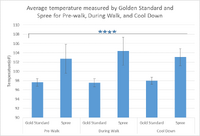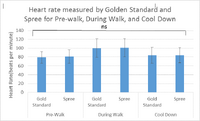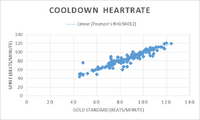BME100 f2014:Group1 L3
| Home People Lab Write-Up 1 | Lab Write-Up 2 | Lab Write-Up 3 Lab Write-Up 4 | Lab Write-Up 5 | Lab Write-Up 6 Course Logistics For Instructors Photos Wiki Editing Help | |||||||
|
OUR TEAM
LAB 3A WRITE-UPDescriptive StatisticsPre-Walk Gold Standard Mean: 97.6 Standard Deviation: 0.799 Standard Error: 0.0571 Spree Mean: 102.7 Standard Deviation: 3.11 Standard Error: 0.239 Walk Gold Standard Mean: 97.527 Standard Deviation: 0.860 Standard Error: 0.0438 Spree Mean: 104.39 Standard Deviation: 3.015 Standard Error: 0.146 Cooling Down Gold Standard Mean: 97.947 Standard Deviation: 0.778 Standard Error: 0.0606 Spree Mean: 103.1 Standard Deviation: 1.85 Standard Error: 0.158 Pre Walk Gold Standard Mean: 79.2 Standard Deviation: 13.0 Standard Error: 1.01 "Spree" Mean: 81.0 Standard Deviation: 15.0 Stand Error: 13.0 Walk Gold Standard Mean: 101 Standard Deviation: 21.0 Standard Error: 1.01 Spree Mean: 101.0 Standard Deviation: 21.0 Standard Error: 1.11 Post Walk Gold Standard Mean: 84.0 Standard Deviation: 18.0 Standard Error: 0.906 Spree Mean: 84.0 Standard Deviation: 17.0 Standard Error: 0.898
ResultsAverage's graphs for Temperature and Heart Rate The golden standards mentioned in these graphs are as follows: Temperature: An Oral Thermometer Heart Rate: The Pulse Oxidation Wrist Monitor Stars denote significance, four stars being very significant, one star denoting a low significance, no stars denotes no significant difference Pearson's R Correlation Graphs AnalysisA paired T-test was used because the comparison was between two groups of related data. T-Test: Temperature Before Walk (p-value): 5.86082E-46 During Walk (p-value): 2.7657E-155 Cool Down (p-value): 1.98512E-63 T-Test: Heart Rate Before Walk (p-value):.203015 During Walk (p-value):0.735103 Cool Down (p-value):0.548900 Pearson's R Values Heart Rate Before Walk: 0.87175 During Walk: 0.89894 Cool Down: 0.94012 Temperature Before Walk: 0.120901 During Walk: 0.034639 Cool Down: -0.173197
Summary/DiscussionPossible Improvements: Some design flaws on the Spree fitness headband include the temperature scale on the app, the design of the headband itself, and the range of the sensor. Recommendations to compensate for these design flaws include creating a sensor to accurately read temperature and instead of the current scale based off a qualitative range. In order to improve the design of the headband itself, the material of the headband could be changed in order to better absorb sweat and make the headband more attractive, instead of a removable block sensors the sensors could be embedded across the headband for more accurate readings, the shape could be changed for a more aesthetic appeal, and different sizes of the headband could be made available for a better fit among customers. Another way to improve customer satisfaction would be to create a universal app that allows both android and iphone users to utilize this health utility. A final way to improve the Spree headband would be to design the sensors in the headband so that they can store data and not always have to be within range of the phone.
LAB 3B WRITE-UPTarget Population and NeedTarget Population The target population of the Insight Contacts is active individuals whom spend time in sunlight. Need The eye is very sensitive to ultraviolet rays from the sun. People take care of their skin with sunscreen, but often the eye itself is still unprotected. So the Insight Contacts adjust color to give the eye protection from harsh light. Many people that spend time in the sun also have problems with hydration. The need is for a hydration monitoring device that is not obtrusive or easy for someone to do at home. The Insight Contacts will have a sensor that tests for sodium levels so that a part of the contact will change color when its user is reaching unsafe hydration levels.
Device DesignOur Product Product Name: Insight Contacts Product Slogan: "Looking Towards a Brighter Future" Product Logo: Design
Inferential StatisticsGold Standard: Sodium Levels Measured by Blood Test No Activity Average: 140.1 mEq/L Standard Deviation: 11.8 Standard Error: 1.20 At Least Two Hours of Physical Activity Average: 151.3 mEq/L Standard Deviation: 12.0 Standard Error: 1.22 Insight Contacts No Activity Average: 142.8 mEq/L Standard Deviation: 8.45 Standard Error: 0.86 At least two hours of Activity Average: 153.0 mEq/L Standard Deviation: 9.03 Standard Error: 0.923 Pearson's R Correlation between Gold Standard and Insight Contacts No Activity: 0.85 At least two hours of activity: 0.765 Paired Two Tailed T-Test: P-Value No Activity: 0.0796 At Least Two Hours of Activity: 0.0273 Gold Standard Using UV Index During Night Time Average: 0.165 mW/cm^2 Standard Deviation: 0.0554 Standard Error: 0.00554 During Day Time Average: 1.700 mW/cm^2 Standard Deviation: 0.400 Standard Error: 0.0400 Going from Outside to Inside Average: 1.19 mW/cm^2 Standard Deviation: 0.701 Standard Error:0.0701 Insight Contacts During Night Time Average: 0.166 mW/cm^2 Standard Deviation: 0.0554 Standard Error: 0.00554 During Day Time Average: 1.70 mW/cm^2 Standard Deviation: 0.394 Standard Error: 0.0394 Going from Outside to Inside Average: 1.18 mW/cm^2 Standard Deviation: 0.700 Standard Error: 0.0700 Pearson's R Correlation for Gold Standard vs. Insight Contacts During Night: 0.983 During Day: 0.9995 Going from Inside to Outside : 0.9900 Paired Two Tailed T-test: P-Value During Night Time: 0.290 During Day Time: 0.261 Going between Inside and Outside: 0.393
Graph
|
|||||||

















